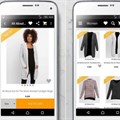#MobileCommerce: The growth of mobile shopping in South Africa

Apparel is beginning to experience a real upswing in the share of ‘goods’ bought online, especially if you consider Spree’s statement that “In mid-2017, total sales at Spree were up 88% year-on-year, sales on the shopping app more than doubled and daily transactions increased by 76%", and Zando’s claim to have sold 80 items a minute during Black Friday 2017?
These numbers alone are a testament to a growing appetite and adoption of online shopping, but now as user behaviour and lifestyle shifts even more to a mobile-dominated world, how has this impacted online shopping itself here at home?
The reaction to this swing towards mobile shopping, and thus catering for it can be clearly seen by looking at the traditional brick and mortars retailers such as Mr Price, Clicks and Woolworths clear investment into not just their e-commerce platforms but mobile platforms as well. While momentum has naturally taken a bit longer for these players to get into the mobile shopping game than the more agile online-only retailers, their presence alone bodes well for not just online retail but mobile shopping in general.
Users that are comfortable buying on one mobile device and app are without a doubt more likely to do so on another, and looking at the huge scale of these respective programs this is a good step at ‘educating’ those more reluctant to try mobile shopping as a whole. All three have now have released apps with the initial focus bar Mr Price, on their loyalty programs, I am sure we can expect the ability to ‘shop’ their apps very soon.
What has been the key drivers for mobile shopping?
Greater access
South Africa is fast catching up on the international trend of adopting a 'mobile first' attitude, with 55% of South Africans having a smartphone, added to this the affordability of smartphones entering the market – such as Huawei, Xiaomi and Hisense to name a few – is allowing more consumers to have devices capable to match the higher ended models which removes a further barrier to how one accesses the internet.
Admittedly, online shopping only accounts for 1% of the total market share currently (possibly ever so slightly more now) and while the starting base is evidently lower resulting in ‘greater’ double-digit percentages as alluded to the two aforementioned online stores, the growing smartphone penetration means that by just being online and doing a half decent job one can ride the wave to a degree as the main two barriers to online shopping fall away, them being 1.) Access to the internet 2.) the cost of that access (data costs).
According to the Mobile in SA Report 2017 by Effective Measure, a very relevant stat for retailers was that 48% of users don’t purchase items when they are on a mobile connection (network connection rather than Wi-Fi), this suggests a potential pain point around data concerns. As the report further indicates respondents are comfortable conducting their banking, purchasing airtime and paying their bills via their devices; retail shopping, however, lags as it initially requires more browsing time and time on the site or app itself.
In South Africa we are seeing a move to finally tackling what I believe are very exorbitant data costs, with the recent ruling by Icasa regarding how network operators handle data rollovers, and let’s not forgot the movement #datamustfall which is building steam, things are moving in the right direction albeit with a lot of kicking and screaming by some. Interestingly, these cases were the motivation behind Zando trialling ‘zero-rated data’ with the largest network in South Africa for a period, with some positive results.
User behaviour
With 70% of unique browsers coming from a mobile source, according to Narrative’s latest May 2018 South Africa Online Insights release for publishers, people are already reading and browsing publishers' websites via their phones in greater numbers than before, a clear indication on content consumption habits. Bolt on the fact that proportion of people accessing Facebook via a mobile device is no less than 87.5%, according to the SA Social Media Landscape 2018 study, provides overwhelming evidence that users' preferred method of accessing content is via mobile.
It would be naïve to think this would fail to translate to shopping online and I'm confident, as most online retailers would agree, that mobile visits share has essentially surpassed that of desktop at this point. That’s just the browsing, but what about making purchases? This can be answered by Effective Measure’s 2017 Ecommerce Report, where 36% of respondents stated that their device of preference when making online purchases were mobile phones and tablets and this is only set to grow.
What about the rest of Africa?
Looking at Africa, we can start to see similar characteristics and very much the same barriers to entry for e-commerce and mobile shopping as faced in South Africa. However, there is tremendous (using a Trumpism here) opportunity as well.
Taking the continent as a whole collective market:
We see as a share of retail, online accounts for a mere 0.63% in Africa, this is far behind the next lowest region being India at 4%. Secondly, Africa is a truly mobile market where numerous successfully started mobile money providers have flourished (Mpesa and the like), an extremely positive indication for anticipated adoption. Internet infrastructure being rather poor users have essentially leapfrogged straight to mobile as an access point, so much so that there is a 93% expected mobile penetration rate by 2020. But that's not all;
- Africa is experiencing a rapidly emerging middle class
- A growing urban population
- Africa boasts the world’s youngest population
- Has the 3rd most internet users behind only India and China
- Decreasing data costs
As South Africa grapples with infrastructure improvements from network data costs, connectivity down to cheaper phones more users will be jumping on the mobile shopping wagon. Keep an eye on Africa, the above points coupled with a young population that is comfortable with technology, transacting online, on their devices is a sure sign the appetite will be there.
For us, the online retailers, the job is far from over. It’s one thing to have the users available that is just half the battle. We need to ensure our mobile properties are fast, light in data usage with simple and easy to use interfaces, good product offering and all the rest that comes with e-commerce. Getting that right places us on a good footing to take advantage of the growing demand for mobile shopping.
Visit our Mobile Commerce special section for further insights throughout the month of July.
























